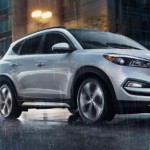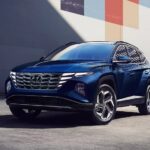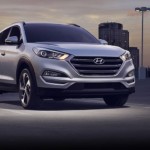The Tucson defies its budget-oriented price with a sleek exterior, well-appointed cabin, and a lavish range of interior tech and safety features. The crossover is also notable for its roomy cabin with 39 cu.ft. of cargo room that rivals the rest of the compact class in terms of pure space. There’s a lot to love about Hyundai’s best-selling SUV, especially for those who appreciate a range of engine options, as the Tucson is the rare crossover that’s offered with three distinct powertrains ranging from a traditional internal combustion engine (ICE) to a hybrid (HEV) and plug-in hybrid (PHEV) model.
This extensive slate of engines found at your local Hyundai dealer gives you the opportunity to customize a Tucson to your specific needs, prioritizing power, efficiency, or range as you see fit. So, what are the differences between the variants when it comes to these three vital factors, and what features do the three have in common? Read on as we compare each model and help you determine which one will make the most valuable addition to your driveway.
Performance
ICE: The traditional gas-powered Tucson is built around a 2.5-liter four-cylinder engine. This setup provides drivers with 187 hp and 178 lb-ft of torque, which are pretty solid figures for the compact crossover segment. The Tucson’s 8.8-second zero-to-sixty time isn’t going to win you any impromptu street races, but it also won’t leave you feeling underpowered while navigating highway traffic. The ICE version of the Tucson comes standard with an eight-speed automatic transmission and front-wheel drive, though an all-wheel drivetrain is also available on the SE, SEL, XRT, and Limited trims.
HEV: Those seeking an even more powerful version of the Tucson should consider the Hybrid model. With a 1.6-liter four-cylinder gas engine producing 180 hp and 195 lb-ft of torque, the Tucson Hybrid is almost as potent as the gas-powered model even before you factor in the electrification: the AC motor and 1.5-kWh lithium-ion battery pack give the Tucson an extra 59 hp and 195 lb-ft of torque to play with for a total of 231 hp and 258 lb-ft. That marks a dramatic improvement over the ICE model and is peppy enough to shave 1.7 seconds off the crossover’s zero-to-sixty time. The Hybrid also boasts standard AWD and a slightly higher top speed at 122 mph, making for a more fun ride all around.
PHEV: The Tucson PHEV is the standout in terms of raw performance. Despite using the same AC motor and 1.6-liter four-cylinder setup as the Hybrid, the PHEV manages to squeeze out an extra 37 hp. With 268 horses on tap, drivers will be able to tackle even the swiftest traffic with confidence, though the PHEV’s zero-to-sixty time is pretty much identical to that of the HEV. Like the HEV, the PHEV comes standard with Hyundai’s TRACtion all-wheel drive (HTRAC AWD) system, an advanced offering that has all the utility of a 4WD system while boasting the performance and fuel efficiency one would expect from a front-wheel drive model. The HTRAC AWD system leverages a complex network of sensors to continually monitor the Tucson’s traction, springing into action to deliver power to the front and rear axles when it’s needed most.

Efficiency
ICE: The traditional Tucson might not be able to compete with the HEV and PHEV models in pure efficiency, but it’s still a solid choice for the ICE side of the compact crossover segment. This SUV’s 2.5-liter four-cylinder engine is at its best when paired with front-wheel drive, delivering 25 MPG in the city and 33 MPG on the highway. The AWD Tucson trails behind the FWD model, but not as much as you might think; with an EPA-estimated 24 MPG in the city and 30 MPG on the highway, the AWD Tucson is still economical while offering the sort of traction that goes a long way toward improving driver confidence when facing tough road conditions.
HEV: The Tucson Hybrid’s 1.6-liter four-cylinder and AC motor make this crossover the perfect choice for those looking to minimize their visits to their local gas station. The entry-level Blue trim is the Hybrid’s most efficient form at an even 38 MPG in the city and 38 MPG on the highway, but the rest of the trim lineup isn’t far behind at 37 MPG in the city and 36 MPG on the highway. These stats—along with a 13.7-gallon gas tank—make the Hybrid a long-haul champ with a total range of 521 miles for the Blue trim and 507 miles for the remaining HEV trims. That’s a significant improvement on both the gas-powered model and the PHEV, which top out at 400 and 420 miles, respectively.
PHEV: Plug-in hybrids offer the best of both worlds, allowing drivers to stick to pure electric power for shorter trips or tap into the gas engine for those longer rides. The average American drives between 30 and 40 miles per day, which makes the Tucson PHEV a great choice for those looking to run some errands, drop the kids off at school, or complete their morning commute without touching the gas tank. The Tucson PHEV boasts an all-electric range of 33 miles and a fuel economy of up to 80 MPGe when the battery is topped off. Running purely on the ICE reduces that number to 35 MPG, but it’s easy to avoid that kind of scenario with just a little bit of planning, as the Tucson PHEV comes with a built-in 7.2-kW charger that can bring the battery to a full charge in under two hours.

Technology
The ICE, HEV, and PHEV Tucsons might differ in some important ways in terms of performance and efficiency, but they’re all on pretty level footing when it comes to interior tech and safety features. The new 2025 Tucson has made some significant strides as far as its infotainment system is concerned, with a new 12.3-inch display offered as a standard feature on every model. Hyundai has also gone against the grain where physical buttons and knobs are concerned, which is a refreshing departure from the touchscreen-happy approach enshrined by many of today’s major automakers. Physical controls make all the difference when it comes to providing a satisfying user experience—something Hyundai has clearly taken to heart when designing the refreshed Tucson.
If one display doesn’t satisfy your need for screen time, simply upgrade to the Tucson’s upper trims to see the standard analog instrument gauge replaced with a fully digital version that spans much of the dashboard. The digital display opens the door to some intriguing customization options and is the perfect pairing for the new 12.3-inch infotainment screen. From running your favorite apps and providing seamless navigation to the inclusion of popular connectivity features like Apple CarPlay and Android Auto, the Tucson’s infotainment system modernizes its interior to better fit in with our increasingly connected world. Optional tech features include a wireless charging pad, Bose premium audio system, digital key smartphone app, and SiriusXM satellite radio.
The Tucson also comes loaded with a full suite of contemporary safety tech, including popular advanced driver assistance systems (ADAS) like automated emergency braking with pedestrian detection and lane-departure warning with lane-keeping assist. Best of all, these features are part of the standard suite, which is probably part of the reason the 2024 Tucson earned both a five-star safety rating from the National Highway Traffic Safety Administration (NHTSA) and a Top Safety Pick+ nod from the Insurance Institute for Highway Safety (IIHS). If you’re in the market for an even more convenient driving experience, Hyundai also offers adaptive cruise control with lane-centering as an optional add-on.
Your Choice of Hyundai Tucson
Want a compact SUV that combines a stylish, tech-heavy cabin and smooth ride with a generous range of efficient powertrains? Look no further than the Hyundai Tucson. The gas-powered Tucson is no slouch, but the HEV’s 38 MPG combined and PHEV’s 80 MPGe and 33 miles of all-electric range make the hybrid models an alluring prospect for any driver looking to save a little money at the pump.
The Tucson Hybrid and PHEV not only offer stellar fuel economy, but they’re also an upgrade in terms of performance, with the latter topping out at 268 hp. Drivers might not flock to the PHEV segment with power in mind, but it’s certainly a nice perk. This crossover also represents a significant value when compared to the rest of the segment and is one of the only models with a starting MSRP that comes in below $30k; combine this modest starting price with Hyundai’s industry-leading warranty, and it’s easy to see why the Tucson has become such a popular choice among today’s drivers.



